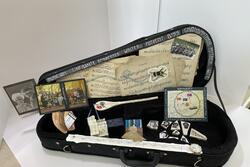Eating Jewish: Recipes for a meaningful Tu B'Shvat
It may seem a little contradictory to celebrate the New Year for trees in North America during the winter, and yet it offers a reminder of the renewal that will soon come with spring (although it may seem far away!).
Tu B’Shvat is a holiday that allows for a fair amount of variation in terms of the way it is celebrated. The kabbalists living in sixteenth-century Safed who held this holiday in high esteem developed a new liturgy and set of rituals for it that are still relevant to our modern day celebrations. They developed a Tu B’Shvat seder modeled on the Passover seder. During this meal four cups of wine are customarily drunk and at least twelve types of fruits and nuts are sampled (some people have increased this number to fifteen because it corresponds to the numerical value of tu).
During the seder, each cup of wine is of a different variety, with the first cup being white wine to symbolize the snows of winter, after which fruits with an inedible exterior are eaten. The second cup should be golden or yellow to symbolize the sap beginning to flow in the trees and is accompanied by fruits that have an edible covering but contain large pits. The third cup of wine is a rose to symbolize the blossoms that are beginning to grow on the trees and is drunk alongside fruit that are completely edible or contain small seeds. The final cup should be red to symbolize the fertility of the land and is not accompanied by fruit because it symbolizes a meaning that is internal.
Whether you are hosting your own Tu B’Shvat seder or not, these two recipes belong on your holiday table because they showcase ingredients that hold significance on this day. Almonds hold special meaning since they are the first tree to flower after winter, sometimes even doing so as early as late January. The almond tree's early blossoming even inspired its Hebrew name, shaked, which means “awakening one.” As a sign of spring, the almond represents hope and renewal.
These almond cookies are probably one of the easiest cookies you will ever make. It literally takes about a minutes to mix up the batter and not that much longer to drop it by spoonful onto a baking tray. These utterly addictive cookies bake up into crispy, golden brown morsels that really allow the delicate flavor of the almonds to shine. They also happen to be gluten free and perfect for Passover (it never hurts to get a head start since these cookies can keep for months).
Easy Almond Cookies
Recipe by Norma Joseph
2 cups sliced raw almonds
½ cup sugar
1 egg white, not whipped
- Line cookie sheet with parchment paper or a Silpat baking mat and preheat oven to 350 degrees.
- In a large bowl, using a fork mix together almonds, sugar and egg white until the almonds are coated and the sugar is mixed in. This will take about a minute to do.
- Using a teaspoon, drop spoonfuls of the almond mixture on the baking sheet and bake for 5 to 10 minutes, until golden brown (my oven runs warm, so you might have to keep them in longer depending). Let the cookies cool completely before attempting to remove them from the baking sheet. The cookies will keep in a tin for months.
The olive is one of the Shevah Minim, or Seven Species (five fruits and two grains) of the Land of Israel, which are customarily eaten on this holiday. The other six species include wheat, barley, grapes, figs, pomegranates and dates. Olives have long played an important role in Jewish life and legends as a symbol of endurance, beauty, light and sanctity.
This babka is a mouthwatering savory take on the traditional sweet babka in which the chocolate or cinnamon filling is replaced with an olive tapenade. This bakes up into a soft, fluffy loaf that would be delicious as the center of a Tu B’Shvat meal. Salads, such as this light orange salad with olives or pomegranate tabouleh woud make excellent sides. However, if making babka doesn’t fit into your schedule, you can simply serve the olive tapenade on small pieces of toasted bread to make delicious crostini.
On this Tu B’Shvat, I hope these recipes offer a reminder of the renewal that is soon to come and if you have some favorite recipes for this holiday, I would love to hear about them in the comments!
Savory Babka filled with Olive Tapenade
Idea adapted from Joan Nathan’s Quiches, Kugels, and Couscous
Olive Tapenade
Adapted from Saveur
1 ¼ cup pitted kalamata olives
½ tablespoon capers, rinsed
1 anchovy filet
2 cloves garlic, roughly chopped
2 tablespoons fresh flat leafed parsley
2 tablespoons extra-virgin olive oil
1 tablespoon lemon juice
- In the bowl of a food processor, combine the olives, capers, anchovy filet, garlic cloves, parsley and olive oil and pulse until the ingredients are finely chopped. Place the olive mixture in a small bowl, add the lemon juice and stir to incorporate. The tapenade will keep in the fridge in a covered container for up to four days.
Babka dough
Adapted slightly from Gil Mark’s Encyclopedia of Jewish Food
1 package (2 ¼ teaspoons) active dry yeast
½ cup warm water
¼ cup sugar
1 cup vegetable oil
4 large eggs
1 teaspoon salt or 2 teaspoons kosher salt
About 3 ½ cups bread flour or unbleached all-purpose flour
Egg wash (1 large egg beaten with 1 teaspoon water)
- In a small bowl, dissolve yeast in a ¼ cup water. Stir in 1 teaspoon sugar and let stand for 5 to 10 minutes, until it becomes foamy.
- In a large bowl, combine the yeast mixture, remaining water, remaining sugar, vegetable oil, eggs, salt, and enough flour to make a dough that holds together. Turn out the dough onto a lightly floured surface and knead until smooth and springy, about 5 minutes. Place in an oiled bowl and turn to coat. Cover with plastic wrap or a damp kitchen towel and let rise in a warm, draft-free place until doubled in bulk, 2 to 3 hours.
- Once the dough has risen, turn it out on a lightly floured surface or in an electric mixer with a dough hook, knead the dough, adding more flour as needed, until smooth and springy, about 5 minutes. Place back in the oiled bowl (adding more oil if necessary) and turn to coat. Cover loosely with plastic wrap or a kitchen towel and let rise again in a warm, draft-free place until doubled in bulk, 2 to 3 hours. You may also cover it with plastic wrap and refrigerate overnight. If refrigerating, let stand at room temperature for 30 minutes before using.
- Grease two 9 inch round pans and set aside.
- Punch down the dough and divide in half. Roll each piece into 12-by-6 inch rectangles. Using a knife spread each of the rectangles with about half of the olive tapenade, leaving a ½ inch border around the edges.
- Beginning on the long side, tuck in the edges and roll the dough up tightly. Cut the roll into about 10 equal pieces and place the pieces, with the cut sides facing up in the pan, in a single layer. Repeat with remaining dough. Cover the pans loosely with plastic wrap or a kitchen towel and let rise until nearly doubled in bulk, about 1 hour.
- Preheat the oven to 350 degrees 8. Brush each babka with the egg wash. Bake until the babkas are golden brown, about 25 to 30 minutes. Let cool and you can then pull the rolls apart into individual babkas.









Ok, so just the photos made me hungry. This is a wonderful article and I will definitely try out the recipe as soon as time permits. It looks great and I truly cannot wait to try it out.
<dl class="multiselect filefield-element"><dd class="form-item filefield-preview">
Recipes in these recent posts always make us feel like we are some sort of culinary expert when we find them online and feel that we can make them as well as the posters. </dd> </dl>